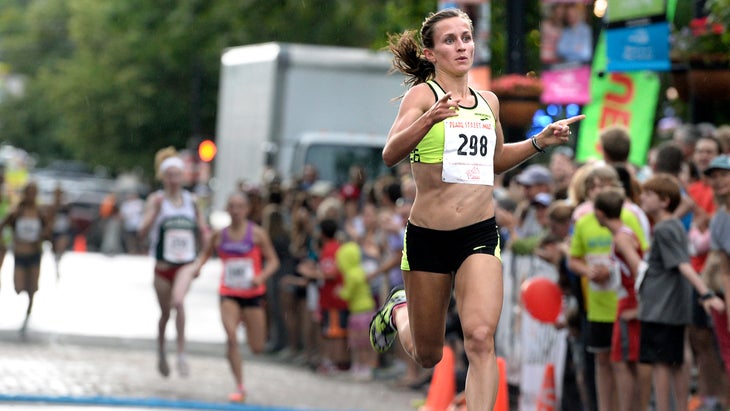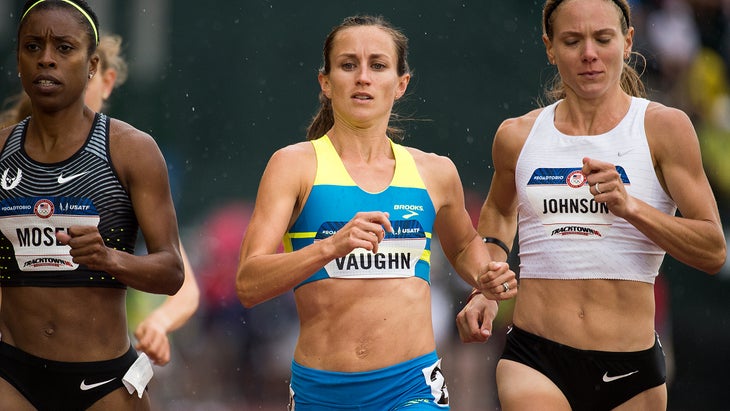Products You May Like
Get access to everything we publish when you
sign up for Outside+.
On August 6, Sara Vaughn was warming up for the Sir Walter Miler in North Carolina while she watched the TV, captivated by Molly Seidel’s Olympic marathon finish in Japan. As Seidel defied all expectations to place third, Vaughn made a decision: she would become a marathoner.
“I was just enthralled and so invested in watching her marathon, I got super motivated,” Vaughn says. The moment was a turning point, and her mind kept wandering to the idea of running her own marathon.
Until last month, Vaughn was known in running circles primarily as a miler and a 1,500-meter runner. Since graduating in 2008 from the University of Colorado—where she was an NCAA All-American in cross-country—Vaughn has been running professionally in Boulder and is coached by her husband, Brent. Her 1,500-meter accolades include making the team for the 2017 World Championships in London, and a seventh-place finish in the 2016 Olympic Trials less than a year after giving birth to her third child.
Vaughn had been flirting with the idea of going longer for a few years, inspired by a string of dominating marathon performances by American women: In 2017, Shalane Flanagan became the first American woman to win the New York City Marathon in 40 years. The following year, Des Linden broke a 33-year drought for American women when she won Boston. Then came Seidel’s bronze-medal performance in Sapporo, Japan, marking the first time an American woman had medaled in the Olympic marathon since Deena Kastor in 2004.
Last month, Vaughn made her marathon debut at the California International Marathon, clocking a time of 2:26.53—the fifth-fastest marathon debut ever by an American woman. On top of her transition from middle-distance racing, it was also her fourth postpartum return to competitive running.
Vaughn’s immediate success in the marathon wasn’t a matter of luck or merely pure talent—it was the product of her cumulative training wisdom, most of which can be applied to any race distance. Here’s how she made the leap from miler to marathoner while coming back from pregnancy, and what she learned in the process about training and racing.
Trust Your Body’s Timeline

Recovery from anything—injury, illness, burnout, or another major life event—rarely fits neatly into a racing schedule. That is especially true for pregnancy.
And each pregnancy presents its own unique challenges. While Vaughn has made three prior postpartum comebacks to competitive running—most famously, perhaps, at the 2016 Olympic Trials—she says that it didn’t make this time any easier or more predictable.
Vaughn’s fourth pregnancy took her the longest to return from. Because the pandemic delayed her racing schedule by a year, including the Olympic Trials, she was able to take time to ease back into elite-level training after giving birth, without rushing to get into racing condition. “As soon as everything was canceled and pushed back, I really focused on making a time schedule based on my body and my needs versus the track schedule,” she said.
Vaughn allowed herself to spend a month cementing a solid foundation. She barely jogged, focusing instead on pelvic-floor physical therapy to build back her base. The next month she jogged a bit more and returned to the weight room to develop strength. “I just really catered the training to what I needed instead of rushing, getting my body ready to handle the hard training I knew I had to do later,” she says. “I always kind of skipped that step with the other pregnancies, and I feel like it made my season last longer this last year. I was able to have better races later in the year.”
Rehearse Potential Challenges

First-time marathon racing can trigger a lot of what-if scenarios and fears that take up mental space. One way to address those anxieties is to do a dress rehearsal during training.
For Vaughn, a major point of concern was her in-race fueling, something she’d never needed to think about in mid-distance races.
“It ended up being totally fine, but we did have to practice it to make me feel better and more confident about it,” Vaughn says. She specifically rehearsed drinking and consuming gels while running at a race pace. Twice she and her husband set up tables on the side of the road, and Vaughn practiced grabbing bottles and ingesting fluid on the fly to ease her nerves about missing a bottle or having an upset stomach.
“I learned the hard way on a few things,” she says. “I definitely gagged on a long run trying to take a gel that I had never tried before.” When it came to the day of the race, all that practice paid off.
In Moments of Chaos, Find Focus
Of course, you can’t predict or control everything that will happen in 26.2 miles of racing. But when the California International Marathon got messy, one strategy that Vaughn employed was focusing on one thing at a time.
Early in the race, Vaughn, accustomed to small, professional fields, struggled to find her place in the race pack and fall into a rhythmic synergy with other runners.
“It was so chaotic,” she says. “There were people sprinting, people yelling, talking. It’s so much different than track races, like, crazy for the first hundred meters, but then everybody sorts themselves out. That first 5K was one of the most chaotic things I’ve ever experienced.”
As Vaughn edged her way to the front of the pack, she was able to find comfort by shifting her focal point to another runner’s pace. “We had one pacer who was designated as the women’s top pacer, and I saw him and I sort of ran to his side. I just kind of sat on his shoulder, and that seemed to calm my brain.”
If you find yourself caught in a storm of jostling, shouting, or uneven pacing, try zoning in on a single thing, like your breath or a competitor a few feet ahead, to find rhythm and flow.
Enjoy the Process and Make Time for Play
Setting a big goal is motivating initially, but to find deeper meaning and satisfaction, it’s critical to find joy in the process.
Vaughn says that the marathon has been the perfect metaphor for how she sets goals for herself, running or otherwise: it’s “one big thing at the end of a really long buildup that is the reason and the impetus for all these other little things.” One way she finds enjoyment in her training buildup is by setting playful process goals.
“Marathon training is not always fun and enjoyable—and it’s never easy—so you have to figure out how to enjoy the hard workouts,” says Vaughn. “I make mini goals. Like, try to meet up with a friend for an easy run once a week. I actually include that into my goals for the week and not just make it all performance based.” That could also mean scheduling time in for family, exploring a new running route regularly, or seeking out a new group to run with a few times a month.
